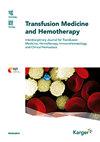在模拟二氧化碳气腹环境的兔失血性休克模型中,臭氧改善自体输血后的氧合并提供器官保护
IF 1.9
4区 医学
Q3 HEMATOLOGY
引用次数: 0
摘要
& lt; b> & lt; i>目标:& lt; / i> & lt; / b>自体输血技术在外科手术中得到了很好的应用,但在腹腔镜手术中收集的红细胞(rbc)可能会丧失其氧合能力。O< sub> 3 & lt; / sub>是一种强氧化气体。本研究探讨O<sub>3</sub>可以提高红细胞的携氧能力,减少炎症反应,并提供器官保护。& lt; b> & lt; i>方法:& lt; / i> & lt; / b>我们建立家兔失血性休克模型,模拟CO<sub>2<气腹和O<sub>3</sub>应用于自体输血前。记录围手术期平均动脉压、动脉血气,分析采血血气及红细胞形态,检测血浆IL-6、ALT、AST、CRE及肺组织病理学POD0、POD3,以及术后生存质量。& lt; b> & lt; i>结果:& lt; / i> & lt; / b>接受模拟CO<sub>2</sub>气腹pH值较低,SaO<sub>2</sub>和更高的PaCO<sub>2</sub>比对照组多。后O< sub> 3 & lt; / sub>治疗,PaO< sub> 2 & lt; / sub>和SaO< sub> 2 & lt; / sub>显著增加,pH值和PaCO<sub>2</sub>不变。CO<sub>2</sub>条件反射,然后通过O<sub>3</sub>治疗。接受CO<sub>2</sub>供血的家兔术后生存质量下降,血浆IL-6水平升高,POD0肺损伤评分升高,POD3 ALT和AST水平升高,O<sub>3</sub>治疗减轻了这些不良后果。& lt; b> & lt; i>结论:& lt; / i> & lt; / b>O< sub> 3 & lt; / sub>可以恢复红细胞功能,显著改善模拟CO<sub>2</sub>气腹,提供器官保护,提高兔失血性休克模型术后生存质量。本文章由计算机程序翻译,如有差异,请以英文原文为准。
Ozone Improves Oxygenation and Offers Organ Protection after Autologous Blood Transfusion in a Simulated Carbon Dioxide Pneumoperitoneal Environment in a Rabbit Hemorrhagic Shock Model
Objectives: Autologous blood transfusion techniques are well applied in surgery, but the red blood cells (RBCs) collected during laparoscopic surgery may forfeit their ability to oxygenate. O3 is a potent oxidation gas. This study investigates whether O3 could improve the oxygen-carrying capacity of RBCs, reduce inflammatory reactions, and offer organ protection. Methods: We established a hemorrhagic shock model in rabbits, and simulated CO2 pneumoperitoneum and O3 were applied before autologous blood transfusion. Perioperative mean arterial pressure and arterial blood gas were recorded, blood gas and RBC morphology of collected blood were analyzed, plasma IL-6, ALT, AST, CRE, and lung histopathology POD0 and POD3 were tested, as well as postoperative survival quality. Results: Autologous blood that underwent simulated CO2 pneumoperitoneum had a lower pH and SaO2 and a higher PaCO2 than the control group. After O3 treatment, PaO2 and SaO2 increased significantly, with unchanged pH values and PaCO2. RBCs in autologous blood were drastically deformed after CO2 conditioning and then reversed to normal by O3 treatment. Rabbits that received CO2-conditioned autologous blood had a compromised survival quality after surgery, higher plasma IL-6 levels, higher lung injury scores on POD0, higher ALT and AST levels on POD3, and O3 treatment alleviated these adverse outcomes. Conclusion: O3 can restore RBC function, significantly improve blood oxygenation under simulated CO2 pneumoperitoneum, offer organ protection, and improve the postoperative survival quality in the rabbit hemorrhage shock model.
求助全文
通过发布文献求助,成功后即可免费获取论文全文。
去求助
来源期刊
CiteScore
4.00
自引率
9.10%
发文量
47
审稿时长
6-12 weeks
期刊介绍:
This journal is devoted to all areas of transfusion medicine. These include the quality and security of blood products, therapy with blood components and plasma derivatives, transfusion-related questions in transplantation, stem cell manipulation, therapeutic and diagnostic problems of homeostasis, immuno-hematological investigations, and legal aspects of the production of blood products as well as hemotherapy. Both comprehensive reviews and primary publications that detail the newest work in transfusion medicine and hemotherapy promote the international exchange of knowledge within these disciplines. Consistent with this goal, continuing clinical education is also specifically addressed.

 求助内容:
求助内容: 应助结果提醒方式:
应助结果提醒方式:


